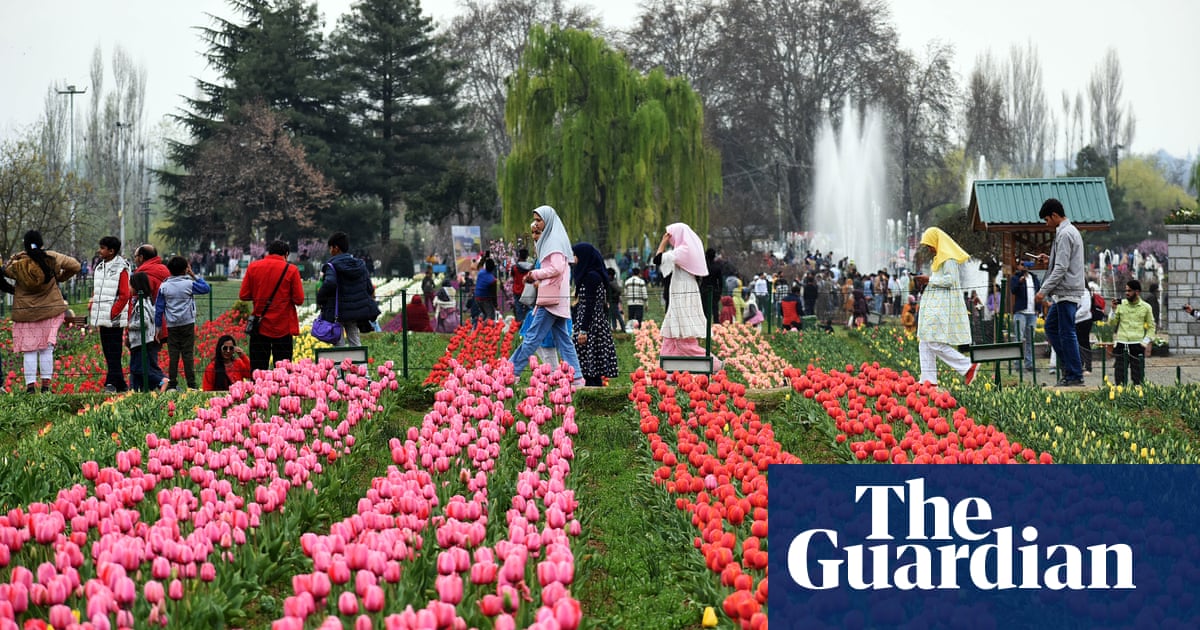
An explosion of colour – and long queues of traffic – marked the opening of Asia’s largest tulip garden in Srinagar, Kashmir.
Over the next month, thousands of people are expected to visit the 30-hectare (74-acre) garden on the shores of the picturesque Dal lake to see more than 60 varieties of blooms during the annual festival, which opened yesterday.
It takes a year, and an army of gardeners, to prepare for the event. “There are over 543 beds spread across the four terraces of the garden,” says the garden supervisor Mushtaq Ahmad Mir, who meticulously maps out which variety and colour of tulip appear in each of the large beds.
Work began on this year’s gardens as soon as the gates closed on the 2022 festival. Stems were pulled up and bulbs retrieved from under the ground. “Each bed can have 2,300 to 2,500 tulips,” says Mohamed Yousuf Khan, one of the festival’s two head gardeners.
“Five people work on each bed, carefully removing the bulbs and placing them in crates. It takes them one full day to do this.”
This backbreaking work continues well into July, when the summer season is at its peak in Kashmir. Ghulam Mohamed Moti, 56, is one of up to 60 gardeners employed on the project. “We wear hats to protect ourselves, but the colour of our clothes and our hats is changed by the heat. You can only imagine what must happen to our bodies.”
The work is done by the permanent staff and men employed as “casual labourers”, even though some have toiled there for decades. “There is no bed in the entire garden that I have not worked on,” says Muzaffar Ahmad Bhat, 36, who has worked at the gardens for 22 years, earning 300 rupees (£3) a day as a casual.
Moti says employees like Bhat should be made permanent and paid better salaries. “They are working on these wages because they are hoping to be made permanent employees with better and regular salaries, otherwise why else would anyone work so hard, around the year, for such wages?”
After harvesting, the bulbs are taken to multiple cold-storage chambers on the edges of the garden. There, they are sorted, graded and those deemed no longer useful (usually about 30%) are discarded. To compensate for the discarded stock, tulips have been imported from the Netherlands every year since 2007, when the festival began.
Srinagar has a string of historic gardens, influenced by the designs of the Mughal emperors, but the Indira Gandhi Memorial Tulip Garden was created specifically to boost tourism. Last year, more than 3.6 million people from across Indian-administered Kashmir, as well as from overseas, visited the garden, up from 2.3 million in 2021, following cancellation in 2020 because of the Covid pandemic.
In August and September, the gardeners focus on ploughing and weeding the beds. “They are ploughed using tractors and manured to maintain the richness of the soil,” says Moti.
By October, furrows have been dug by hand along the length of the beds with 4ft between them, and then the task of planting more than 1.5m bulbs begins.
In winter, the gardeners tend the saplings, working day and night to keep them frost-free and ensure they’re not eaten by the wild boars that prowl the nearby Zabarwan hills. Mesh-wire fencing has been put up around the garden this year to help keep the animals out.
The labour doesn’t stop now the festival has opened. The gardening team work in shifts, watering the beds and making sure visitors don’t pick the flowers, as well as collecting rubbish.
“It’s like tending to a baby,” says Khan. “We make sure the baby doesn’t catch cold, that it is presentable, that it has good clothes. All of this till the show is ready in April, when we present it to the people.”












